When at booting Windows a black screen appears instead of the usual desktop, users begin to frantically search for a solution to the problem. The situation is not pleasant: the computer is turned on, responds to user actions, but it is almost impossible to interact with it. Why does a black screen appear when loading Windows 7 and other versions of Microsoft OS? How to remove it? Let's try to answer these questions.
Causes
To eliminate the cause of the black screen, you first need to identify it. There are several possible options:
- Using an unlicensed copy of Windows.
- Viral infection.
- Damage system files or registry keys.
- Problems with the video card and drivers.
- Hardware malfunctions.
It is most often impossible to cope with hardware problems without replacing the equipment. As for software failures, the first thing you should do is try to run the last known good configuration.
If this option did not help and when you turned on the system a black screen with a cursor appeared again, then you will have to check Windows in safe mode.
If you have Windows XP or Windows 7 on your computer, there will be no problems starting Safe Mode:
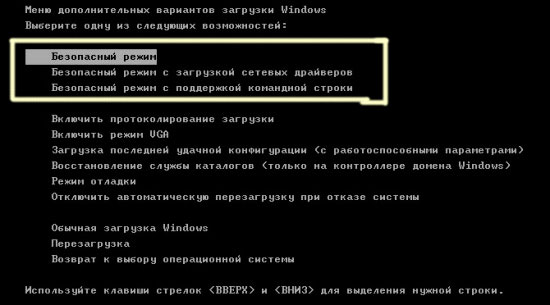
For Windows 8 and Windows 10, this option is not suitable, since the F8 key does not work here. The boot option selection menu is launched through the parameters, but since you cannot see them due to the black screen, you can use the installation flash drive.
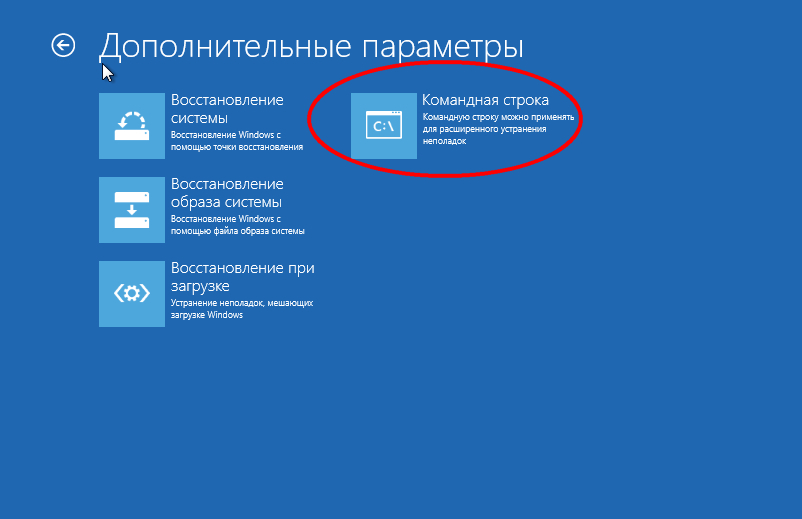
In the interpreter window, you need to enter the command “bcdedit /set (globalsettings) advancedoptions true”. After pressing the Enter key, the computer will restart and Safe Mode will start. To return the system to normal state in command line you need to enter “bcdedit /deletevalue (globalsettings) advancedoptions”.
Troubleshooting
If you are using an unlicensed copy of Windows, then you need to somehow eliminate this shortcoming:
- Buy license key and activate the system.
- Use an activator or delay.
After successful activation, the black screen issue should disappear. If the black screen remains, you will have to resort to other methods.
Reinstalling video card drivers
If you have problems displaying images, the first thing you need to do is check your video card drivers. Perhaps they fell off or simply began to work incorrectly. Download stable working software available for free from the manufacturer's website. But first, let's see what drivers you need.
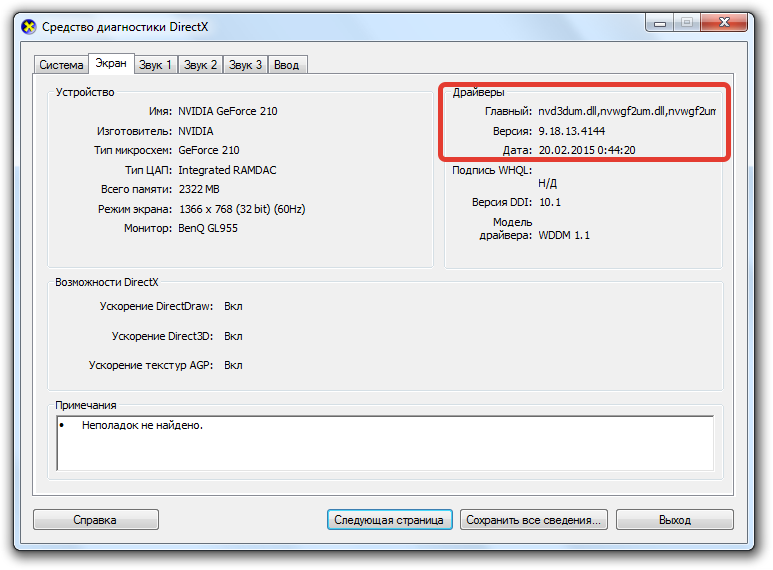
In the window you can see exact model video cards, as well as version installed driver. All you have to do is download the necessary software and install it on your computer, and then check the system again.
Registry fixes
Often the appearance of a black screen is associated with the activity of viruses that replace important entries in the registry. To get rid of this problem, you will have to edit the system registry.
- Press Win+R.
- Type "regedit".
- Find the HKEY_LOCAL_MACHINE/SOFTWARE/Microsoft/WindowsNT/CurrentVersion/Winlogon branch.
Find the "Shell" parameter. It must be singular and have the value “explorer.exe”. If there are other Shell options, remove them. 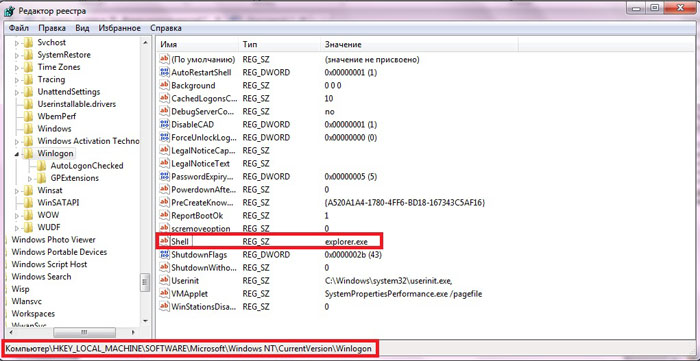
If you find the “Shell” parameter, double-click on it with the left button to open the editing window. Delete all unnecessary entries and enter the value “explorer.exe”, then save the changes by clicking “Ok”.
It is advisable to check the system in safe mode using an antivirus and cleaning utilities like Dr. WebCureIT. Run a scan of your computer, removing any malicious files found before attempting to boot into normal mode again.
System Restore
Another effective way to eliminate a black screen is to roll back to a checkpoint when the computer was working without failures. If it is impossible to start system recovery through the “Task Manager” or the “Run” menu, then you can use this interesting method:
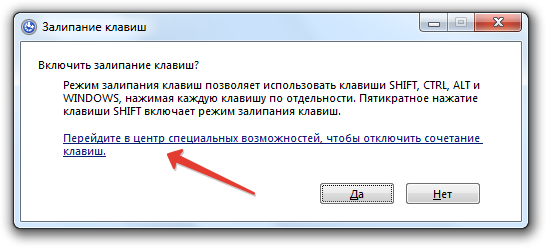
This method will only work if you have previously enabled system recovery and checkpoint storage. Otherwise, you will have to use tools launched from the installation media to perform recovery.
Black screen Windows 10
The appearance of a black screen on Windows 10 is usually due to incorrect work video card drivers. If you have a second monitor connected, then it may also be the culprit for the problem with displaying the work screen.
On Windows 10, sometimes a full reboot and shutdown helps quick launch.
Get ready, you will have to act blindly (the method works if you are sure that the system boots, but do not see the desktop).
- Turn on your computer.
- Enter your password account and press Enter (don't forget to enable the correct layout). Wait a few seconds.
- Press Win+R and wait a bit again.
- Type “shutdown /r” and press Enter (don’t forget about the layout).
- Press Enter again after a few seconds.
The computer should restart. If after a restart the image appears, then with a high degree of probability the cause of the black screen lies in the incorrect operation of the drivers after a quick start. To prevent the problem from recurring:
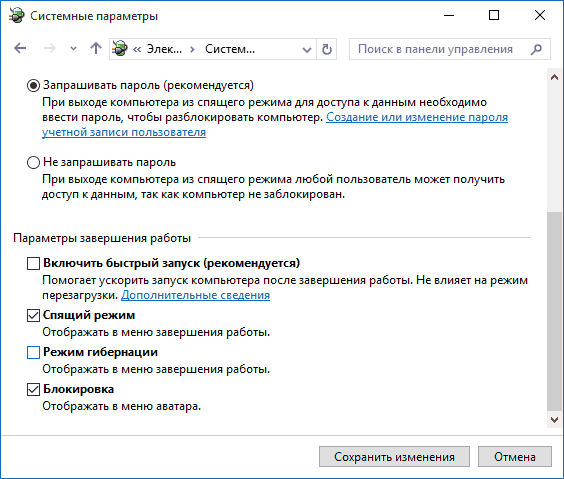
Click "Save Changes" to apply the new configuration. If you have correctly identified the cause of the black screen, then after disabling fast startup, this problem will no longer appear. If the method does not help, you will have to boot into safe mode and manually remove the video card drivers, as described above.
If after updating or Windows installations 10, and also after a reboot it was already successful installed system you are greeted by a black screen with a mouse pointer (and possibly without it), in the article below I will talk about possible ways fix the problem without having to reinstall the system.
The problem is usually due to the drivers not working properly NVidia video cards and AMD Radeon, however this is not the only reason. Within the framework of this instruction, we will consider that case (the most common in Lately), when, judging by all the signs (sounds, computer operation), Windows 10 loads, but nothing is displayed on the screen (except, perhaps, the mouse pointer), it is also possible that a black screen appears after sleep or hibernation (or after shutdown and turning on the computer again). Additional options this problem in the instructions. To begin with, a few quick ways solutions for common situations.
- If the last time you shut down Windows 10, you saw the Please wait, do not turn off your computer message ( installation in progress updates), and when you turn it on you see a black screen - just wait, sometimes updates are installed this way, it can take up to half an hour, especially on slow laptops (Another sign that this is the case -).
- In some cases, the problem may be caused by a connected second monitor. In this case, try disabling it, and if this does not work, then log into the system blindly (described below, in the section about rebooting), then press the Windows keys + P (English), the down key once and Enter.
- If you see the login screen and a black screen appears after login, then try the next option. On the login screen, click on the on-off button at the bottom right, and then, while holding Shift, click "Reboot". In the menu that opens, select Diagnostics - Extra options- System Restore.
If you encounter the problem described after removing a virus from your computer, and you see a mouse pointer on the screen, then the following guide is more likely to help you: . There is another option: if the problem appeared after changing the partition structure on the hard drive or after damage to the HDD, then a black screen immediately after the boot logo, without any sounds, may be a sign of the inaccessibility of the volume with the system. More details: (see the section about the changed partition structure, despite the fact that the error text is not displayed for you, this may be your case).
Reboot Windows 10
One of the working ways to fix the black screen problem after repeated turning on Windows 10, apparently, is quite workable for owners of AMD (ATI) Radeon video cards - completely restart the computer, and then disable Windows 10 fast startup.
To do this blindly (two methods will be described), after booting the computer with a black screen, press the Backspace key (left arrow to delete a character) several times - this will remove the lock screen splash screen and remove any characters from the password entry field if you they were accidentally introduced there.
After this, switch the keyboard layout (if required, the default in Windows 10 is usually Russian, you can almost guarantee switching with the Windows + Space keys) and enter your account password. Press Enter and wait for the system to boot.
The next step is to restart the computer. To do this, press the Windows key (logo key) + R on your keyboard, wait 5-10 seconds, enter (again, you may need to switch the keyboard layout if your system is Russian by default): shutdown /r and press Enter. After a few seconds, press Enter again and wait about a minute, the computer should reboot - it is quite possible that you will see an image on the screen this time.
The second way to restart Windows 10 with a black screen is after turning on the computer, press the Backspace key several times (or you can use the space bar or any character), then press the Tab key five times (this will take us to the on/off icon on the lock screen), press Enter, then - the “Up” key and Enter again. After this, the computer will restart.
If none of these options allow you to restart your computer, you can try (potentially dangerous) forced shutdown computer by long holding the power button. And then turn it back on.
If, as a result of the above, an image appears on the screen, then the problem is precisely in the operation of the video card drivers after quick startup (which is used by default in Windows 10) and to prevent the error from reoccurring.
Disabling Windows 10 Fast Startup:
- Right-click on the Start button, select Control Panel, and in it - Power Options.
- On the left, select "Power Button Actions."
- At the top, click "Change settings that are currently unavailable."
- Scroll down the window and uncheck the “Enable Fast Startup” checkbox.
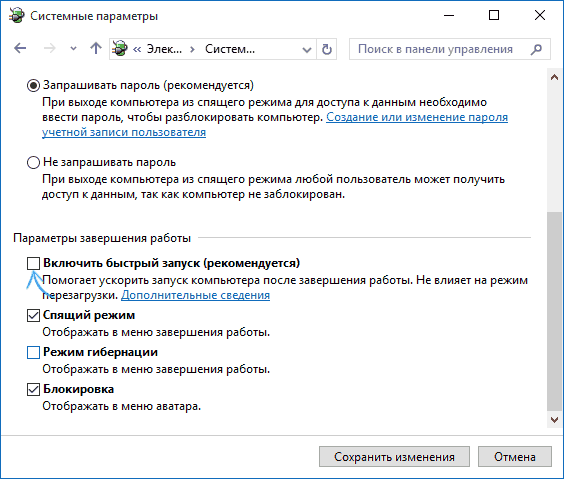
Save your changes. The problem should not be repeated in the future.
Using Integrated Video
If you have an output for connecting a monitor not from a discrete video card, but from motherboard, try turning off the computer, connecting the monitor to this output and turning on the computer again.
There is a good chance (if the integrated adapter is not disabled in UEFI) that after turning it on, you will see an image on the screen and will be able to roll back the discrete video card drivers (via Device Manager), install new ones, or use system recovery.
Removing and reinstalling video card drivers
If previous method didn’t work, you should try to remove the video card drivers from Windows 10. You can do this in safe mode or in low screen resolution mode, and I’ll now tell you how to get into it, seeing only a black screen (two methods for different situations) .
First option. On the login screen (black), press Backspace several times, then Tab 5 times, press Enter, then up once and, while holding Shift, Enter again. Wait about a minute (the diagnostic, recovery, system rollback menu will load, which you probably won’t see either).
Next steps:
- Down three times - Enter - down twice - Enter - left twice.
- For computers with BIOS and MBR - once down, Enter. For computers with UEFI - down twice - Enter. If you don’t know which option you have, press “down” once, and if you get into the UEFI (BIOS) settings, then use the two-click option.
- Press Enter again.
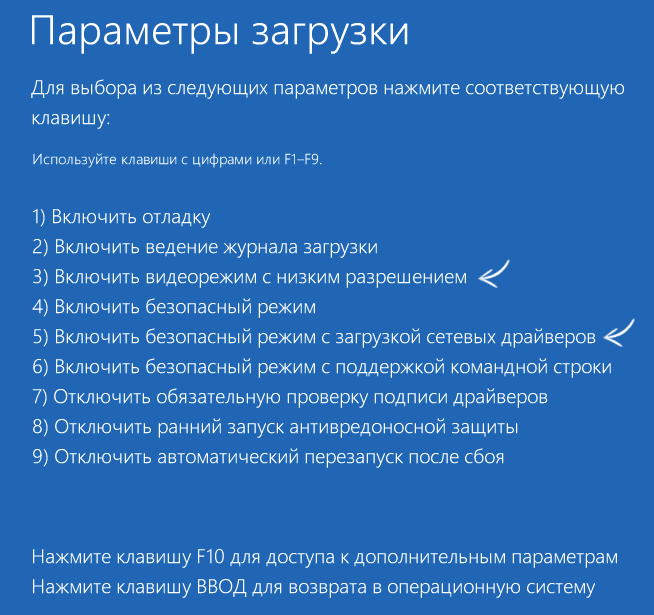
The computer will restart and show you special boot options. Using the number keys 3 (F3) or 5 (F5) to enter Low Screen Mode or Safe Mode with Networking. After booting, you can either try to run System Restore in the Control Panel, or remove the existing video card drivers, and then restart Windows 10 in normal mode(the image should appear), install them again. (see - for AMD Radeon the steps will be almost the same)
If this method of booting your computer does not work for some reason, you can try the following option:
- Log into Windows 10 with a password (as this was described at the beginning of the instructions).
- Press Win+X keys.
- Press up 8 times and then Enter (a command prompt will open as administrator).
At the command line, enter (must be in English): bcdedit /set (default) safeboot network and press Enter. After that enter shutdown /r press Enter, after 10-20 seconds (or after the sound alert) - Enter again and wait until the computer reboots: it should boot into safe mode, where you can remove the current video card drivers or start system recovery. (In order to return to normal booting in the future, in the command line as an administrator, use the command bcdedit (default) /deletevalue safeboot)
Additionally: if you have bootable flash drive with Windows 10 or a recovery disk, then you can use them: (you can try using restore points, or, as a last resort, reset the system).
If the problem persists and you can’t figure it out, write (with details about what, how and after what actions happened and is happening), although I can’t promise that I can give a solution.
After installing the operating room Windows systems 7 many people face the problem "black screen of death". Microsoft developers have not yet been able to recommend anything sensible in this situation. However, when I encountered this problem myself, I dug through a lot of information and was able to overcome the black screen when loading Windows. Now I can give you a few recipes on how to get rid of the glitch.
Preventive actions before the first launch of Windows 7
First: If you operating system installed, but not yet launched, use the utility Black Screen Fix. You can download it here: . Download the utility and start the OS. In the future, these manipulations will avoid the appearance of a black screen. I’ll say right away that it’s impossible to give a 100% guarantee, but it helps in most cases.
When the problem has already manifested itself “in all its glory”
Option two: your system has already shown a black screen when loading Windows and there is nothing you can do about it.
Try these manipulations (it helped me):
First, we reboot the computer;
We register in the system and see a black screen appear with a flickering white mouse cursor (the computer must be connected to the Internet, the blackness of the screen does not interfere with this);
Press the key combination Ctrl+Alt+Del - this command will call the task manager, and if it is blocked by the administrator, then there are instructions on how to bypass it;
Now go to the “Task Manager”, there we look for the “Applications” tab, press the button “ New task»;
In the window that appears, type the following command: “C:/Program Files/Internet Explorer/explorer.exe” “http:/info.prevx.com/download.asp?GRAB=BLACKSCREENFIX” (just don’t forget to put quotation marks, this is important) ;
Click Ok, the program starts loading immediately;
In the window that appears, click “Run”, the program downloads and runs;
After this, we reboot the computer. Let's check, check the computer
This method helps in almost 100% of cases.
The option is so simple, so effective
My friend's black screen problem was solved perfectly. After installing Windows 7, there was a black screen when loading Windows and a flickering mouse cursor. He did nothing, waited 25 minutes and the computer rebooted, twice in a row. After the second boot, the operating system appeared on the screen.
A couple more tips
I pressed the Ctrl+Alt+Del key combination, selected the “Task Manager” menu item, then “Applications” and “New task”, entered Explorer. Immediately after this, the “Desktop” opened. That's it, you can work. It depends on everyone, but sometimes it helps.
When the message “Start Windows” appeared, I pressed the combination Ctrl+Alt+Del, and the second boot began immediately. After downloading, two items appeared:
1. Restore system startup;
I chose point 1, the process took 15-25 minutes, after which the “Desktop” appeared. I didn’t touch anything for a couple of minutes, the OS starts working normally, the black screen when loading Windows no longer bothers me.
Last tip
You tried all the previous recommendations, but nothing changed. Think about it, maybe the power on your computer monitor is not turned on? Find a small button, usually in the lower right corner, and press it. The black screen when loading Windows will be replaced by a beautiful Windows 7 screensaver.




